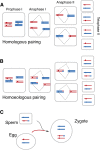The BOY NAMED SUE quantitative trait locus confers increased meiotic stability to an adapted natural allopolyploid of Arabidopsis
- PMID: 24464296
- PMCID: PMC3963567
- DOI: 10.1105/tpc.113.120626
The BOY NAMED SUE quantitative trait locus confers increased meiotic stability to an adapted natural allopolyploid of Arabidopsis
Abstract
Whole-genome duplication resulting from polyploidy is ubiquitous in the evolutionary history of plant species. Yet, polyploids must overcome the meiotic challenge of pairing, recombining, and segregating more than two sets of chromosomes. Using genomic sequencing of synthetic and natural allopolyploids of Arabidopsis thaliana and Arabidopsis arenosa, we determined that dosage variation and chromosomal translocations consistent with homoeologous pairing were more frequent in the synthetic allopolyploids. To test the role of structural chromosomal differentiation versus genetic regulation of meiotic pairing, we performed sequenced-based, high-density genetic mapping in F2 hybrids between synthetic and natural lines. This F2 population displayed frequent dosage variation and deleterious homoeologous recombination. The genetic map derived from this population provided no indication of structural evolution of the genome of the natural allopolyploid Arabidopsis suecica, compared with its predicted parents. The F2 population displayed variation in meiotic regularity and pollen viability that correlated with a single quantitative trait locus, which we named BOY NAMED SUE, and whose beneficial allele was contributed by A. suecica. This demonstrates that an additive, gain-of-function allele contributes to meiotic stability and fertility in a recently established allopolyploid and provides an Arabidopsis system to decipher evolutionary and molecular mechanisms of meiotic regularity in polyploids.
Figures








References
-
- Arabidopsis Genome Initiative (2000). Analysis of the genome sequence of the flowering plant Arabidopsis thaliana. Nature 408: 796–815 - PubMed
-
- Bomblies K. (2010). Doomed lovers: Mechanisms of isolation and incompatibility in plants. Annu. Rev. Plant Biol. 61: 109–124 - PubMed
-
- Broman K.W., Wu H., Sen S., Churchill G.A. (2003). R/qtl: QTL mapping in experimental crosses. Bioinformatics 19: 889–890 - PubMed
-
- Cifuentes M., Grandont L., Moore G., Chèvre A.M., Jenczewski E. (2010). Genetic regulation of meiosis in polyploid species: New insights into an old question. New Phytol. 186: 29–36 - PubMed
Publication types
MeSH terms
LinkOut - more resources
Full Text Sources
Other Literature Sources
Miscellaneous

